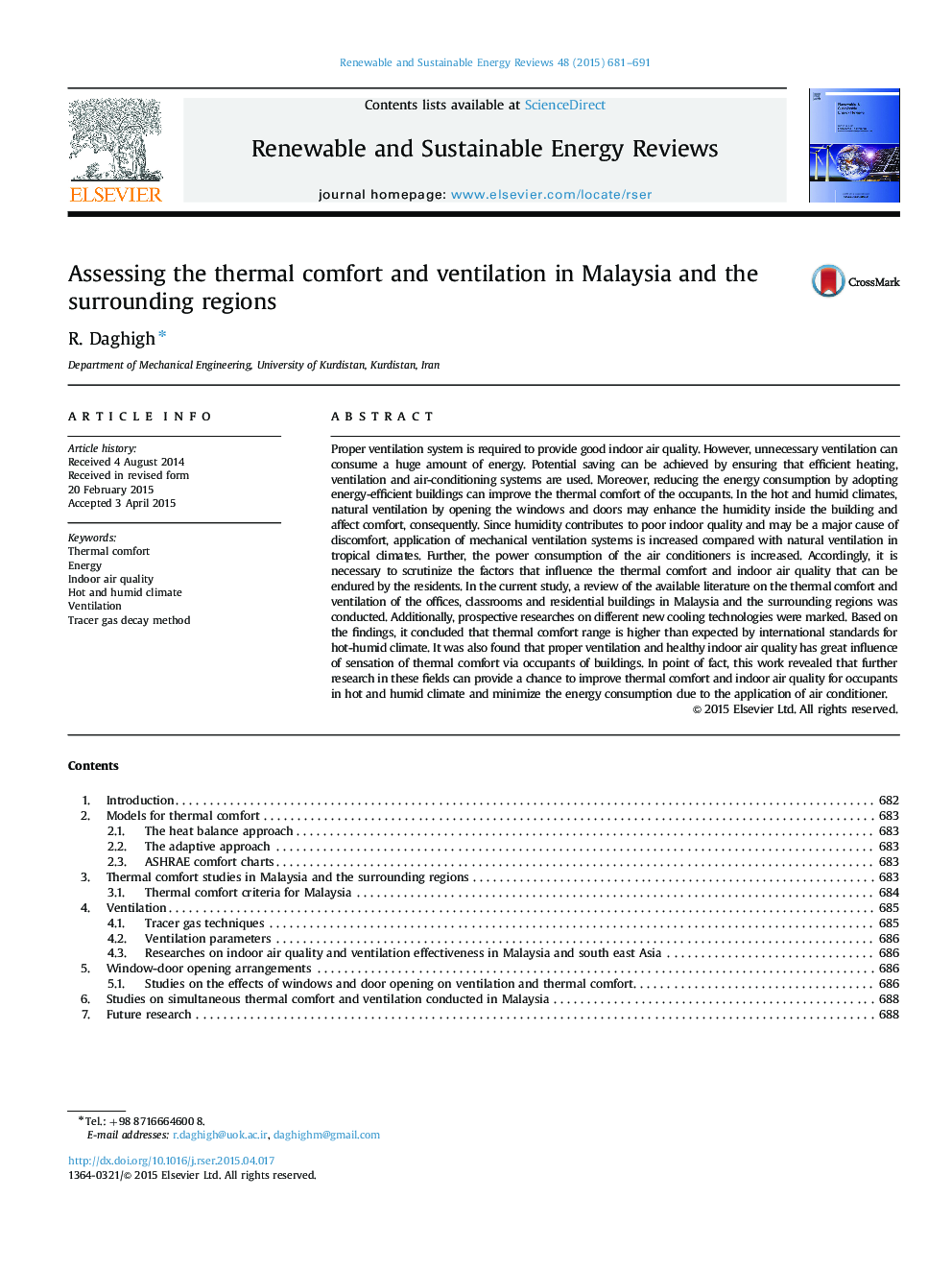| کد مقاله | کد نشریه | سال انتشار | مقاله انگلیسی | نسخه تمام متن |
|---|---|---|---|---|
| 8116534 | 1522337 | 2015 | 11 صفحه PDF | دانلود رایگان |
عنوان انگلیسی مقاله ISI
Assessing the thermal comfort and ventilation in Malaysia and the surrounding regions
ترجمه فارسی عنوان
ارزیابی راحتی حرارتی و تهویه در مالزی و مناطق اطراف آن
دانلود مقاله + سفارش ترجمه
دانلود مقاله ISI انگلیسی
رایگان برای ایرانیان
کلمات کلیدی
راحتی حرارتی، انرژی، کیفیت هوا داخل آب و هوای گرم و مرطوب، تهویه روش تجزیه گاز ردیاب،
ترجمه چکیده
سیستم تهویه مناسب برای ارائه کیفیت هوا در محیط داخلی مناسب است. با این حال، تهویه غیر ضروری می تواند مقدار زیادی انرژی مصرف کند. صرفه جویی در توانایی را می توان با اطمینان از استفاده از سیستم گرمایش، تهویه و تهویه مطبوع کارآمد به دست آورد. علاوه بر این، کاهش مصرف انرژی با اتخاذ ساختمان های با انرژی کارآمد می تواند راحتی حرارتی اشخاص را بهبود بخشد. در هوای گرم و مرطوب، تهویه طبیعی با باز کردن پنجره ها و درب ها می تواند رطوبت داخل ساختمان را افزایش دهد و در نتیجه باعث راحتی می شود. از آنجایی که رطوبت در کیفیت داخلی ضعیف است و ممکن است یکی از دلایل اصلی ناراحتی باشد، استفاده از سیستم های تهویه مکانیکی در مقایسه با تهویه طبیعی در هوای گرمسیری افزایش می یابد. علاوه بر این، مصرف برق سیستم های تهویه مطبوع افزایش می یابد. بر این اساس، لازم است که عوامل موثر بر راحتی حرارتی و کیفیت هوای داخل ساختمان را که می توانند ساکنان را تحت تأثیر قرار دهند، مورد بررسی قرار دهند. در مطالعه حاضر، بررسی ادبیات موجود در مورد راحتی حرارتی و تهویه دفاتر، کلاس های درس و ساختمان های مسکونی در مالزی و مناطق اطراف آن انجام شد. علاوه بر این، تحقیقات آینده نگر در فن آوری های جدید خنک کننده جدید مشخص شده است. بر اساس یافته ها، این نتیجه گیری شده است که محدوده آسایش حرارتی بالاتر از انتظارات استانداردهای بین المللی برای آب و هوای گرم و مرطوب است. همچنین مشخص شد که تهویه مناسب و کیفیت هوا در محیط سالم، تاثیر زیادی از احساس راحتی حرارتی توسط اشخاص از ساختمان ها دارد. در واقع، این کار نشان داد که تحقیقات بیشتر در این زمینه می تواند فرصتی برای بهبود راحتی حرارتی و کیفیت هوای داخل محوطه در هوای گرم و مرطوب را فراهم کند و مصرف انرژی را به دلیل استفاده از سیستم تهویه مطبوع به حداقل برساند.
موضوعات مرتبط
مهندسی و علوم پایه
مهندسی انرژی
انرژی های تجدید پذیر، توسعه پایدار و محیط زیست
چکیده انگلیسی
Proper ventilation system is required to provide good indoor air quality. However, unnecessary ventilation can consume a huge amount of energy. Potential saving can be achieved by ensuring that efficient heating, ventilation and air-conditioning systems are used. Moreover, reducing the energy consumption by adopting energy-efficient buildings can improve the thermal comfort of the occupants. In the hot and humid climates, natural ventilation by opening the windows and doors may enhance the humidity inside the building and affect comfort, consequently. Since humidity contributes to poor indoor quality and may be a major cause of discomfort, application of mechanical ventilation systems is increased compared with natural ventilation in tropical climates. Further, the power consumption of the air conditioners is increased. Accordingly, it is necessary to scrutinize the factors that influence the thermal comfort and indoor air quality that can be endured by the residents. In the current study, a review of the available literature on the thermal comfort and ventilation of the offices, classrooms and residential buildings in Malaysia and the surrounding regions was conducted. Additionally, prospective researches on different new cooling technologies were marked. Based on the findings, it concluded that thermal comfort range is higher than expected by international standards for hot-humid climate. It was also found that proper ventilation and healthy indoor air quality has great influence of sensation of thermal comfort via occupants of buildings. In point of fact, this work revealed that further research in these fields can provide a chance to improve thermal comfort and indoor air quality for occupants in hot and humid climate and minimize the energy consumption due to the application of air conditioner.
ناشر
Database: Elsevier - ScienceDirect (ساینس دایرکت)
Journal: Renewable and Sustainable Energy Reviews - Volume 48, August 2015, Pages 681-691
Journal: Renewable and Sustainable Energy Reviews - Volume 48, August 2015, Pages 681-691
نویسندگان
R. Daghigh,
